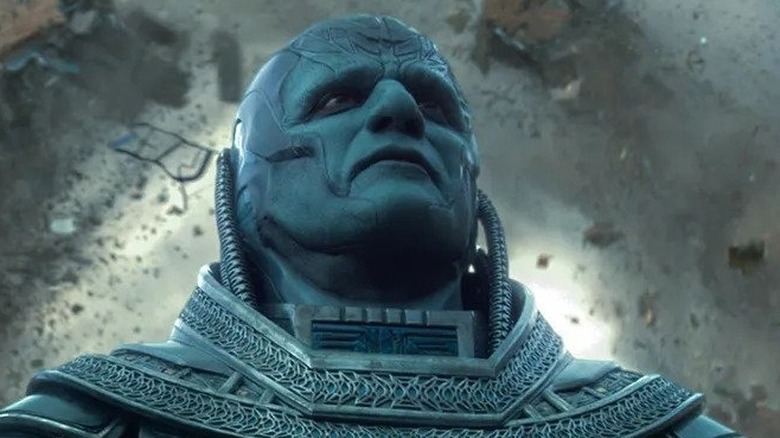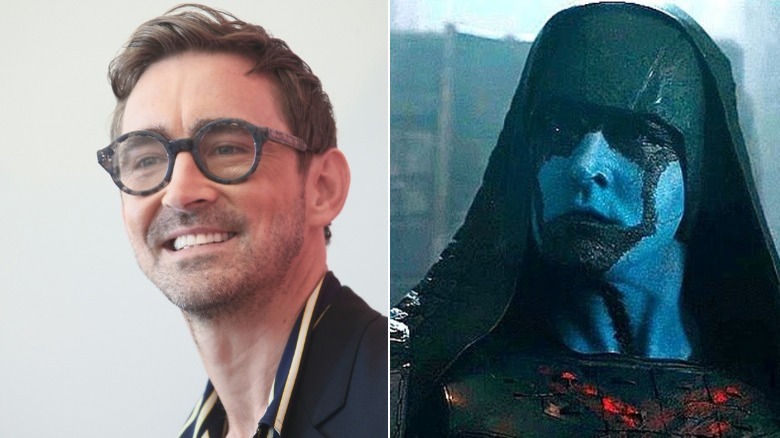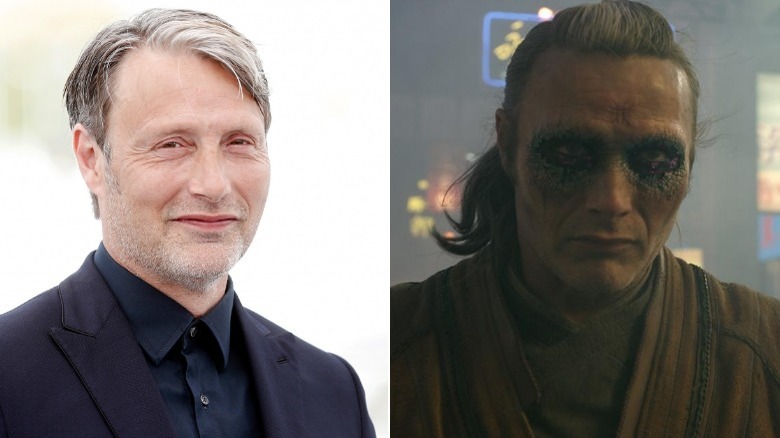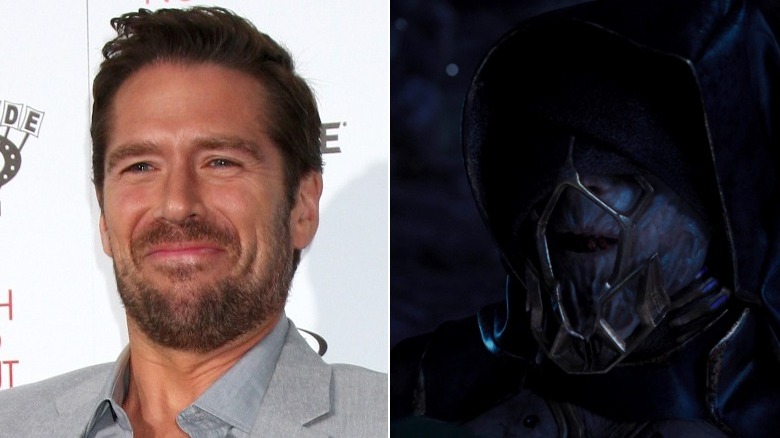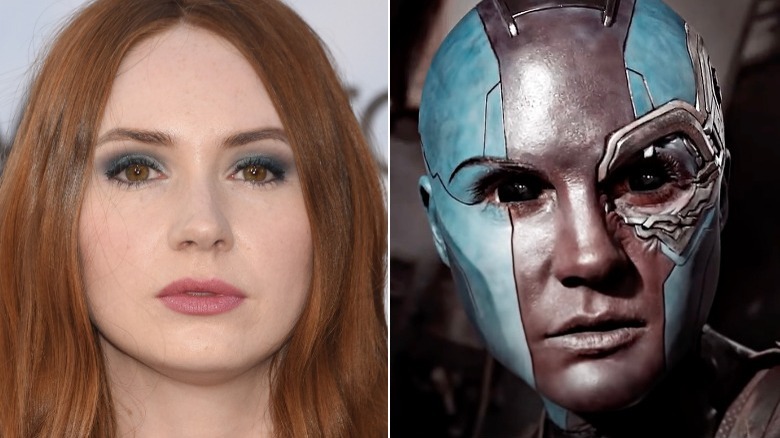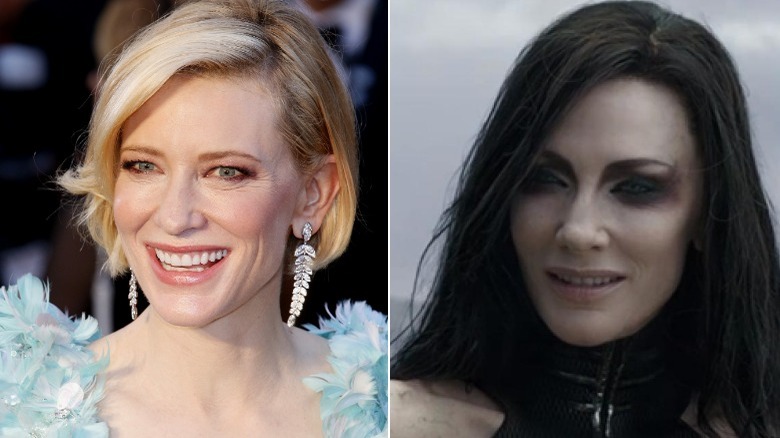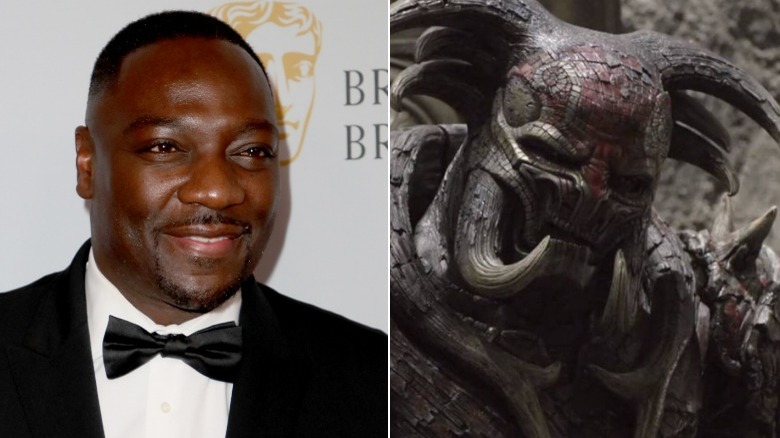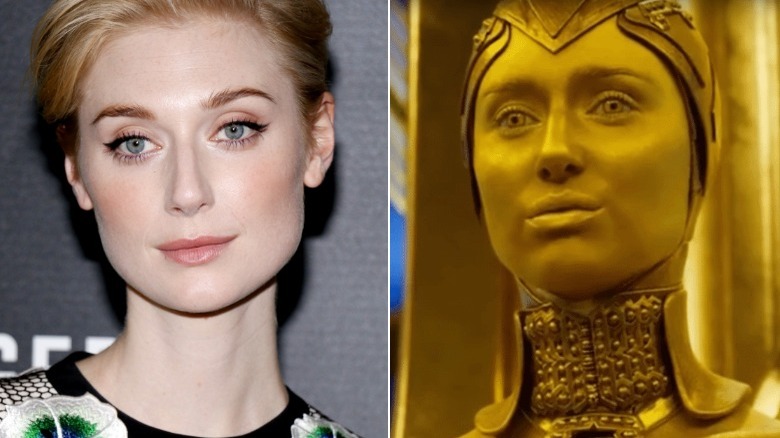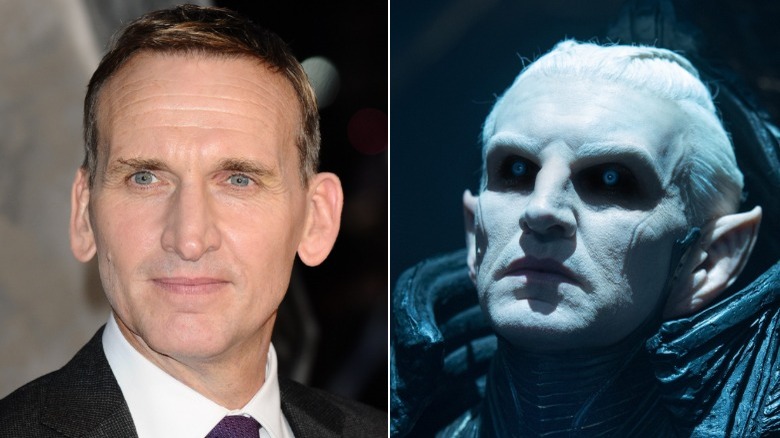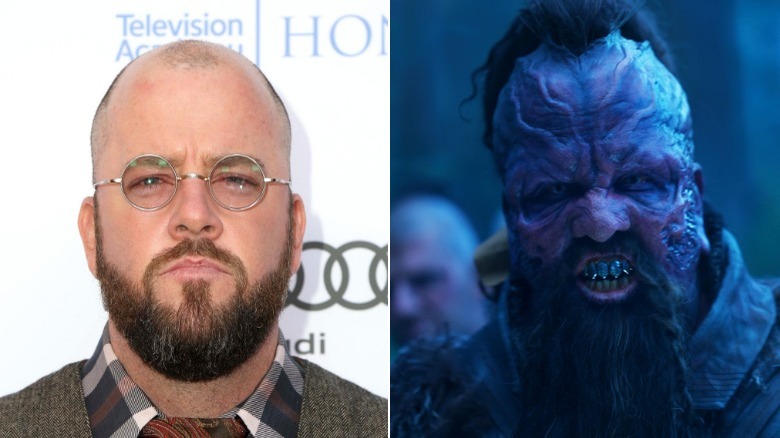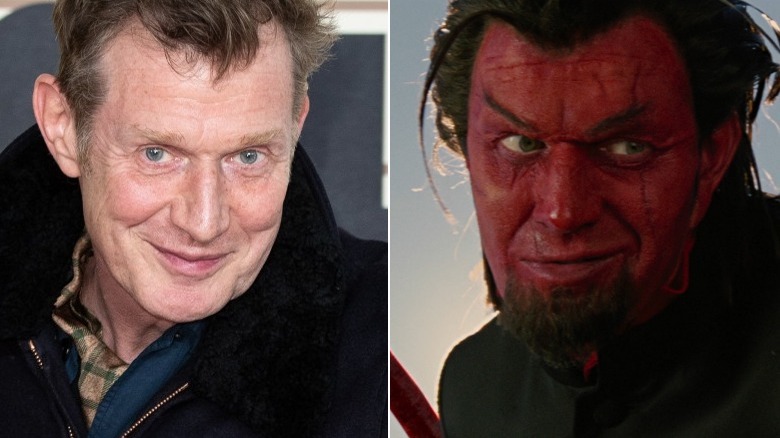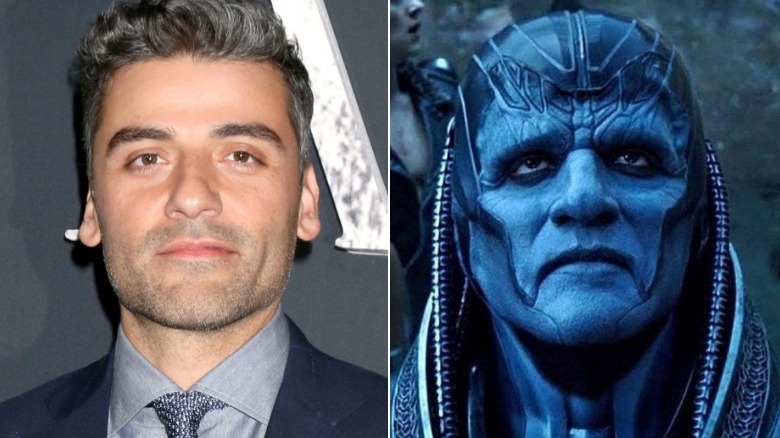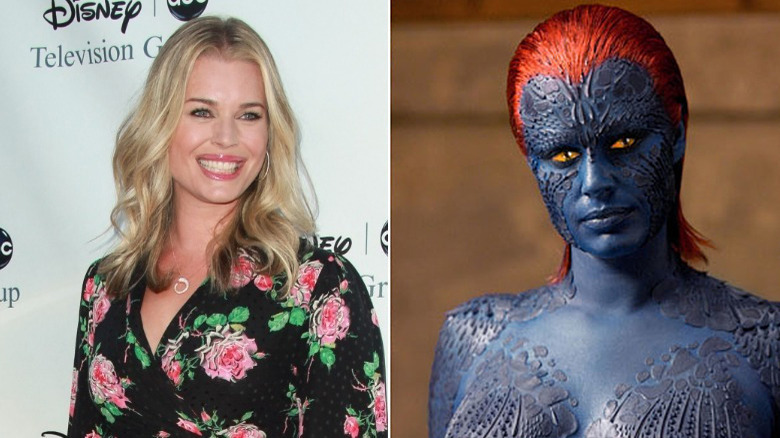What These Marvel Villains Really Look Like Under The Makeup
The release of "X-Men" in 2000 proved that comic book superheroes, when taken seriously, could result in films that were more than just kiddie flicks. Following in the wake of the success of "X-Men" was Sam Raimi's beloved "Spider-Man" movies which perfectly translated the personal struggles and explosive battles of the source material to the big screen. While some of the other Marvel movies that came out around this time were met with middling success — like 2005's "Fantastic Four" and the Nicolas Cage "Ghost Rider" films — it was the Marvel Cinematic Universe that really established that superhero movies could please fans and critics alike.
Advancements in CGI have certainly done their part to bring countless fantastical images from the comics to the big screen, but let's not discount the amazing makeup effects that have brought these beloved characters to life. Some incredibly talented makeup artists have done an amazing job transforming regular people into the otherworldly and alien characters from the source material, and as much as we love superheroes, we thought we'd shine the spotlight on the baddies of various Marvel movies. Without further ado, here are what the Marvel movie villains look like under the makeup.
Lee Pace as Ronan the Accuser
Lee Pace made his MCU entrance in "Guardians of the Galaxy" as classic comic book baddie Ronan the Accuser, a cutthroat Kree zealot who has declared war on Xandar. In the film, Ronan strikes a deal with Thanos: if Ronan retrieves a mysterious orb for the Mad Titan, he will be given support for his planned genocide of the Xandarians. However, when Ronan discovers that the orb contains the Power Stone of the fabled Infinity Stones, he decides to keep it for himself and promises to kill Thanos as part of his campaign. After a brutal battle with the Nova Corps, the Guardians of the Galaxy manage to free the Power Stone from Ronan's possession and use it to kill him. Ronan would later reappear in "Captain Marvel" which takes place years before the events of "Guardians of the Galaxy."
Elizabeth Yianni-Georgiou designed the makeup effects for Ronan the Accuser (as well as other members of the cast), and was even nominated for an Academy Award for her work on "Guardians of the Galaxy." Yianni-Georgiou gave Business Insider a look at how she made up Lee Pace for the film, which included painting his face a soft violet color, creating veins, and applying black accents around his eyes and lips. With the addition of the character's headdress and purple contact lenses to give him a more alien look, Pace was transformed into a vicious alien conqueror.
Mads Mikkelsen as Kaecilius
Kaecilius was the primary antagonist in 2016's "Doctor Strange," a sorcerer who used to train under the Ancient One with the hope of finding answers to life's difficult questions after the deaths of his wife and son. However, he became disillusioned with the Ancient One and the Masters of the Mystic Arts when he felt they failed him in his attempts to reunite with his deceased family. This led him to work for Dormammu who promised to bring the Dark Dimension to Earth as this would destroy death and allow everyone to live forever. However, the Dark Dimension is not exactly a nice place, so Doctor Strange sets out to defeat Kaecilius with the help of Wong and Karl Mordo.
While actor Mads Mikkelsen's Kaecilius didn't have to endure quite the same amount of makeup prosthetics that many other Marvel villains had to, applying the distinctive otherworldly design around his eyes was no small task, as he revealed in an interview with Entertainment Weekly, saying, "It took almost three hours. It's a nice warm-up! You get in the chair, and you try to relax and focus on the day's work ahead of you. So I don't mind at all. My skin is disagreeing completely, because for weeks in a row of doing that, your skin gets very sick and tired of doing it."
Alexis Denisof as The Other
The Other may have only appeared in two Marvel Studios films, but he was around during some important moments in the Marvel Cinematic Universe. An original character not based on any specific comic book IP, the Other made his first appearance in 2012's "The Avengers" as the personal servant for Thanos, giving Loki the scepter which contained the Mind Stone, as well as control of Thanos' Chitauri army. While Loki was ultimately unsuccessful in his task of taking over the Earth, Thanos and the Other struck a deal with Ronan the Accuser in which they'd provide him support for his personal vendetta against the Xandarians when he brought them the Power Stone. During a heated argument in "Guardians of the Galaxy," Ronan kills the Other in front of an uncaring Thanos, and that's the last we see of him in the MCU.
Mysterious and menacing perfectly describe the Other's distinctive design, so it's no surprise that it was more complex to create than it looks. Ironhead Studio, led by sculptor Jose Fernandez, are responsible for creating the Other, as seen in this Instagram post from the studio, which highlights the prosthetic pieces for the arms, chest, and face that the actor had to wear.
Karen Gillan as Nebula
While it's true that Karen Gillan's Nebula is on the side of the angels now, there was a time when she was a straight-up villain. The adopted daughter of Thanos and sister of Gamora, Nebula was trained from a young age to be a ruthless fighter, given cybernetic upgrades from her father. In "Guardians of the Galaxy," Nebula is initially assigned to help Ronan the Accuser bring Thanos the Orb, but when Ronan discovers that it contains the Power Stone, he exits their deal and promises to kill Thanos himself. Wanting to get back at her father for the years of torture he subjected her to, Nebula sides with Ronan and promises to help him kill Thanos. Of course, Nebula eventually does help in the effort to kill Thanos, but when she does it's with the Avengers.
Turning the cheery Scottish lass Karen Gillan into the deadly blue-skinned alien cyborg Nebula was an arduous task, but the person behind the transformation knocked it out of the park. Special effects makeup artist David White told Business Insider that the process required 4 hours and 15 minutes to apply the numerous makeup prosthetics and that "the five-piece prosthetic was a puzzle of butt joins and blend offs all on the same pieces and the density of the prosthetic changes to accommodate the need to control the amount of prosthetic movement from one piece to another." Of course, there's quite a bit more to Gillan's transformation into Nebula.
Cate Blanchett as Hela
"Thor: Ragnarok" saw the debut of the classic villain Hela, who in the film is the daughter of Odin and therefore sister of Thor and Loki. With her increasing ruthlessness as she helped him conquer the nine realms, Odin locked her away in Hel, the land of the dead. However, when Odin passed away he was no longer able to keep Hela at bay, allowing her to escape and invade Asgard with her undead army. Thor returns to Asgard with Loki and Valkyrie and, with the help of a resurrected Surtur, are ultimately able to defeat Hela.
Hela's look in "Thor: Ragnarok" is ripped straight from the comic book design by original artist Jack Kirby. While actress Cate Blanchett's Hela didn't have to endure as much makeup to transform her naturally glowing appearance into a dreary goddess of death (most of her final look was accomplished with CGI), she did have to have some black makeup applied around her eyes to sell the fact that she spent most of her existence in the underworld. Blanchett turned to a surprising source of inspiration for her character's design, telling Yahoo "when I was starting to think about how she might look, I went back to the fanbase. All these girls were doing Hela makeup looks on YouTube. I thought about what their takes on her were. I spoke to Marvel about what she would look like when she would be unmasked, so she wasn't a faceless, generic baddie."
Adewale Akinnuoye-Agbaje as Algrim/Kurse
A member of the Dark Elves, Algrim is one of the few survivors of the war between Bor (the father of Odin) and Malekith (the leader of the Dark Elves). Following this fateful battle, Algrim and the last Dark Elves hibernated in suspended animation on their home planet until they were awakened five thousand years later when Jane Foster absorbed the Aether. As a show of loyalty to Malekith and the Dark Elves, Algrim had himself transformed into a member of the Kursed, an enhanced soldier with increased strength, durability, and ferocity. While Kurse caused considerable damage to the Asgardians, he was ultimately killed by Loki when he activated one of his Black Hole Grenades.
Actor Adewale Akinnuoye-Agbaje played both Algrim and Kurse and, as he indicated in an interview with Cinemablend, both roles required a large amount of time in the makeup chair: "For Algrim it takes about two and a half hours, possibly three, depends. And for Kurse, it takes about an hour and a half and sometimes I have to do them both at the same day so we're looking about five hours. That's just to put on and to take off but it definitely is a labor of love but I've got the most skilled prosthetic team, as you can see, working with me so they make it very, very easy but it's long."
Elizabeth Debicki as Ayesha
Elizabeth Debicki brought Marvel villainess Ayesha to the big screen in "Guardians of the Galaxy Vol. 2." This live-action version of the character is the Golden High Priestess of the Sovereign who charges the Guardians with the task of protecting Anulax Batteries from the Abilisk, a massive tentacled alien creature that has a hunger for power sources. However, when Ayesha discovers that Rocket Raccoon stole some of her batteries, she sends an army after the Guardians, only for them to escape. She then hires Yondu Udonta and his Ravagers to bring them to her, but she is ultimately betrayed by Yondu. Refusing to let the Guardians get away with what they did to her, Ayesha creates Adam Warlock, who will appear in "Guardians of the Galaxy Vol. 3," played by Will Poulter.
It might be easy to assume that because Elizabeth Debicki's makeup consists entirely of only one color that it was a fairly straightforward process. However, in an interview with Vulture, the actress revealed that it was not as simple as it might look, stating that she was "completely gold. Down to my fingernails. Gold wig. Gold skin. Gold contacts, even! ... A month later, I'd be in an airplane and find gold in my ear. Or even up my nose! It's so bad."
Christopher Eccleston as Malekith
Malekith is a classic Thor villain who made his live-action debut in 2013's "Thor: The Dark World," portrayed by Christopher Eccleston. As the leader of the Dark Elves, he waged a war against the Asgardians and tried to bring about universal darkness with the Aether. While Malekith and the Dark Elves were long thought to have been wiped out in the battle, he and others survived and returned to exact revenge against the Asgardians and retrieve the Aether to resume his original plan. As the Convergence was taking place in the Greenwich borough of London — where all nine realms were alignment — Malekith and his forces are stopped by Thor and Loki, and the villain is sent back to Svartalfheim where he is killed with one of his warships.
The menacing presence Christopher Eccleston brought to the role of Malekith was bolstered by the makeup he wore that included elongated pointed ears, a pale complexion, and contact lenses. According to Eccleston, the process took surprisingly long, as revealed by Digital Spy: "The first couple of days it was about seven hours, eight hours. I think we got it down to six and a half. It's a day's work before [anything]." In fact, the arduous makeup process was a shock to the actor himself, as he claimed that "Marvel were dishonest to me, because they never, ever let me know that there'd be that amount of make-up."
Chris Sullivan as Taserface
Taserface is a relatively obscure Marvel Comics villain, so it was a bit of a surprise that he'd been given the big budget treatment in "Guardians of the Galaxy Vol. 2," where he was played by Chris Sullivan. In the film, Taserface is a member of the Ravagers led by Yondu Udonta until he becomes disenchanted with Yondu's leadership and starts a mutiny against him. When Yondu, Rocket, and Groot escape their prison cells in a fight that results in the Ravagers' ship exploding, Taserface carries out one last act of defiance and sends the Sovereign Yondu's coordinates so they could hunt him down themselves. However, just before he dies in the ship's explosion, Taserface gets laughed at because of his goofy name, a running joke throughout the film.
Taserface is a pretty brutal-looking alien character, and getting the right look for him was no easy task. In an interview with Entertainment Weekly, Chris Sullivan went into some detail on just what was required to apply the complex makeup appliances: "The makeup process started off at about three-and-a-half hours and we whittled it down to about two-and-a-half, as the makeup team got more and more practiced at it. It was quite involved."
Jason Flemyng as Azazel
Azazel is a relatively minor X-Men villain and only appeared in one film, "X-Men: First Class." He was a member of the Hellfire Club led by Sebastian Shaw, and was part of their effort to recruit fellow mutants to their cause of starting a nuclear war to eliminate homo sapiens and make way for homo superior. The Hellfire Club is ultimately defeated by the inaugural team of X-Men, and it's later revealed in "X-Men: Days of Future Past" that Azazel is killed by Project WideAwake and is operated on by Trask Industries.
The cinematic version of Azazel is pretty close to his comic book counterpart, from his distinctive red skin to his prehensile tail to his overall devilish appearance. However, creating that look was an arduous process, one that actor Jason Flemyng was glad he didn't have to go through, as revealed by MovieWeb, where he said, "I don't think I will be back. Initially I was gutted, but then, I remembered I had to get up at two in the morning, I had to be painted red and be slightly out of focus and posed a lot, and that was sort of it. Now I don't have to do that."
Oscar Isaac as Apocalypse
Apocalypse has always been one of the X-Men's greatest foes in the comics, and he was definitely no slouch in the films either. Fans were given a taste of his immense power at the end of "X-Men: Days of Future Past" when he's building pyramids with his mind alone. However, it was "X-Men: Apocalypse" that truly revealed his godlike abilities as he set out to recruit powerful mutants to be his Four Horsemen in his quest to remake the world in his image. As mighty as Apocalypse is, he is ultimately defeated by another godlike mutant, a Phoenix-powered Jean Grey.
Oscar Isaac brought Apocalypse to life and had to undergo a complicated makeup process to complete the character's ornate look. In an interview with GQ, Isaac revealed that getting into and out of the makeup was far from a cakewalk, stating that "I couldn't move my head and I had to sit on a specially designed saddle, because that's the only thing I could really sit on ... and I was just gonna be sitting and I couldn't really move, and like, sweating inside the mask and the helmet. And then getting it off was the worst part, because they just had to kind of scrape it off for hours and hours."
Rebecca Romijn as Mystique
Mystique has been one of the most vital characters in the "X-Men" films, and has had a complex arc over the course of the seven movies she appeared in. While Jennifer Lawrence played the character in a more antiheroic manner, Rebecca Romijn initially portrayed Mystique as a straight up villain. In the first three "X-Men" movies, Mystique is part of Magneto's Brotherhood of Mutants, whose goal is to overthrow homo sapiens' place as the dominant species on the planet in the name of mutant supremacy. However, near the end of "X-Men: The Last Stand," Mystique has her powers removed and is disowned by Magneto. Feeling betrayed, Mystique gives the U.S. government the location of Magneto's base.
To get into the chameleon-like character of Mystique, Rebecca Romijn had to have a complicated set of prosthetics applied to her entire body, which was incredibly time-consuming. In an interview with Looper, Romijn stated that, "It was no joke! My call time was at midnight to be ready at 9AM. It was a nine-hour makeup process. We did, over the course of three movies, manage to get it down to seven hours, but that was still ... It was a big deal."
